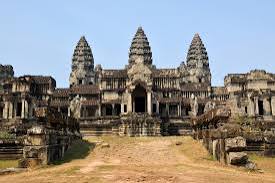Thailand–Cambodia Border Conflict 2025: Causes, Impact, and the Road to Peace
On 24 July 2025, deadly clashes erupted between Cambodia and Thailand, marking a serious escalation in the long-standing Thailand–Cambodia border conflict. At least 34 people have been killed, and fighting has been reported in 12 locations along their disputed boundary.
The heart of the conflict lies in a territorial dispute surrounding the Preah Vihear Temple, an 11th-century Hindu temple perched on the border. The day’s violence began when Thailand’s military responded to Cambodian rocket and artillery fire, which killed at least 11 civilians. Both sides accused each other of initiating the hostilities.
The flare-up has sparked global concern due to its potential to destabilize Southeast Asia and undermine ASEAN unity. India, in particular, is watching closely as the conflict could affect trade flows and regional stability.
Reasons for the Conflict
The roots of the Thailand–Cambodia border dispute stretch back over a century to the 1904 Franco–Siamese Treaty, which loosely defined the boundary between Siam (modern-day Thailand) and French Indochina (present-day Cambodia, Laos, and Vietnam).
In 1962, the International Court of Justice (ICJ) awarded the temple itself to Cambodia, but ownership of the surrounding land remained unresolved. This ambiguity has fueled decades of tension, nationalism, and intermittent clashes.
Other flashpoints include the Ta Muen Thom Temple, another ancient site claimed by both nations. Since 2008, sporadic military exchanges have occurred, with the last major deadly clash taking place in 2011—until the 2025 escalation.
The dispute remains both a legal and emotional battle, with historical pride and territorial sovereignty driving tensions as much as military strategy.
Military Comparison: Thailand vs. Cambodia
- Cambodia
- ~75,000 active-duty troops
- ~200 tanks
- No fighter jets, limited transport aircraft
- Small navy for river and coastal patrols
- Defence budget: under $500 million
- Global Firepower rank (2025): 95th of 145 nations
- Relies on legal and diplomatic strategies more than military strength
- Thailand
- ~130,000 professional troops + over 100,000 conscripts
- ~400 tanks
- Advanced fighter jets and modern navy
- Defence budget: several billion USD annually
- Considerably more technologically advanced than Cambodia

Economic and Humanitarian Impact
The conflict has severely disrupted both economies, though Cambodia faces a heavier blow due to its smaller, less diversified economy.
Economic losses include:
- Thailand: ~$300 million lost in just five days of fighting
- Potential loss of 40–50 billion baht in border exports over three months
- Collapse in tourism, with 5,266 bookings cancelled across nine provinces since July 23
- Closure of key attractions, including Phanom Rung Historical Park
Tourism impact:
- Cambodia: Sharp decline in visitors to Siem Reap and conflict-adjacent areas
- Widespread travel advisories issued by the US, France, Japan, and South Korea
Humanitarian crisis:
- Over 300,000 civilians displaced
- Thailand: ~140,000 evacuated
- Cambodia: ~135,000 relocated
- Refugees face shortages of food, shelter, and healthcare
- Hospitals overcrowded and under-resourced
- 150,000 students have had their education disrupted
Geopolitical Undercurrents
The border has also become a proxy arena for US–China rivalry:
- Thailand leans closer to the United States
- Cambodia maintains strong ties with China
This external dimension raises the stakes for regional stability and complicates peace negotiations.
Pathways to Peace
Peace is essential to halt further loss of life and economic damage. In 2025, ASEAN successfully brokered a ceasefire, leading to peace talks in Malaysia.
Key measures for sustainable peace include:
- Troop withdrawals and border monitoring
- Dedicated peace-building programs in disputed areas
- UN-assisted satellite surveillance and joint patrols
- Cultural exchange initiatives to reduce mistrust
- Better refugee rehabilitation programs focusing on education, healthcare, and livelihoods
ASEAN’s diplomatic mediation is vital for ensuring that the Preah Vihear dispute does not reignite into open warfare.
Conclusion
The Thailand–Cambodia conflict over the Preah Vihear Temple has caused civilian casualties, economic losses, and mass displacement. While the 2025 ceasefire offers hope, the real test lies in whether both governments can transform a site of historic beauty into a symbol of peace rather than a flashpoint for conflict.
Only through dialogue, mutual respect, and regional cooperation can this century-old dispute be resolved once and for all.
For more such interesting blogs, please visit: https://vichaardhara.co.in/


